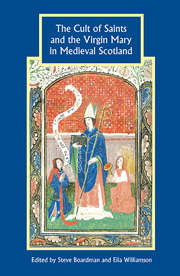Book contents
- Frontmatter
- Contents
- List of Illustrations and Tables
- List of Contributors
- Abbreviations
- Introduction
- 1 The Big Man, the Footsteps, and the Fissile Saint: paradigms and problems in studies of insular saints' cults
- 2 St Munnu in Ireland and Scotland: an exploration of his cult
- 3 The struggle for sanctity: St Waltheof of Melrose, Cistercian in-house cults and canonisation procedure at the turn of the thirteenth century
- 4 Royal and aristocratic attitudes to saints and the Virgin Mary in twelfth- and thirteenth-century Scotland
- 5 A saintly sinner? The ‘martyrdom’ of David, duke of Rothesay
- 6 Wo/men only? Marian devotion in medieval Perth
- 7 Is eagal liom lá na hagra: devotion to the Virgin in the later medieval Gàidhealtachd
- 8 Scottish saints' legends in the Aberdeen Breviary
- 9 Mothers and their sons: Mary and Jesus in Scotland, 1450–1560
- 10 The ‘McRoberts thesis’ and patterns of sanctity in late medieval Scotland
- Index
2 - St Munnu in Ireland and Scotland: an exploration of his cult
Published online by Cambridge University Press: 05 October 2013
- Frontmatter
- Contents
- List of Illustrations and Tables
- List of Contributors
- Abbreviations
- Introduction
- 1 The Big Man, the Footsteps, and the Fissile Saint: paradigms and problems in studies of insular saints' cults
- 2 St Munnu in Ireland and Scotland: an exploration of his cult
- 3 The struggle for sanctity: St Waltheof of Melrose, Cistercian in-house cults and canonisation procedure at the turn of the thirteenth century
- 4 Royal and aristocratic attitudes to saints and the Virgin Mary in twelfth- and thirteenth-century Scotland
- 5 A saintly sinner? The ‘martyrdom’ of David, duke of Rothesay
- 6 Wo/men only? Marian devotion in medieval Perth
- 7 Is eagal liom lá na hagra: devotion to the Virgin in the later medieval Gàidhealtachd
- 8 Scottish saints' legends in the Aberdeen Breviary
- 9 Mothers and their sons: Mary and Jesus in Scotland, 1450–1560
- 10 The ‘McRoberts thesis’ and patterns of sanctity in late medieval Scotland
- Index
Summary
Munnu, or Fintan Munnu, as he is sometimes called in Scotland, is an apparently straightforward saint, with an eighth-century vita, an obit in the Annals of Ulster, an appearance in Adomnán's Vita Columbae, and a name – Mun or Mund – which appears in a distinctive form in place-names in Scotland: four Kilmuns in Argyll, and an Eilean Munde near Ballachulish in Lochaber. He is intriguing too in the survival of traces of his cult in fifteenth-century references to a keeper of his crozier, and in the surname Mac Gille Mund, evident in Argyll at least into the seventeenth century.
This cheerful opening may sound like a prelude to the cruel news that in fact Munnu is not straightforward at all – that his obit is unreliable, that the person in Vita Columbae is someone else altogether, and that Kilmun may commemorate another saint. I will indeed flag up some potential problems towards the end of this chapter but for now I am going to treat Munnu as if he were a nice simple saint, uncontaminated by overlap or confusion with other saints. And I treat his strange double name – Fintan Munnu – as a helpful aid in our attempts to track his cult. This name derives from the common name Fintan, of which there were many bearers,5 followed by an affectionate form of the same name, arrived at thus: Fintan > *Mo Finn (‘my Finn’ where the f is lenited and therefore silent) > Mun > Munnu.
- Type
- Chapter
- Information
- Publisher: Boydell & BrewerPrint publication year: 2010



